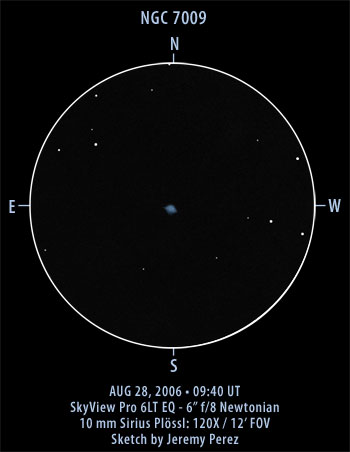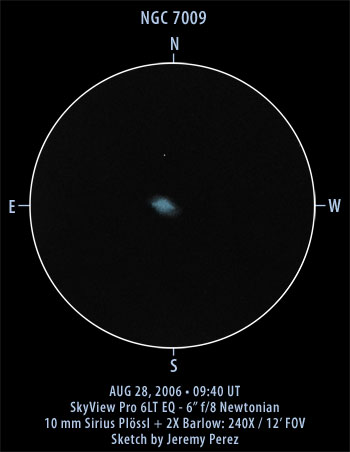

Observation Notes:
With a prominent Zodiacal Light rising in the northeast, I headed for a planetary nebula. I had a look at the Helix Nebula, but didn’t feel like re-sketching it at this point. It’s going on two years since Brent Archinal helped me find the Saturn Nebula while observing at Wupatki National Monument. The nebula shows up as an out-of-focus star at low power (37.5X). Higher power reveals an elongated bun of light with a very noticeable cyan color. Adding the UltraBlock filter helps define it better, but it is easily visible without.
Elongation of the core of the nebula runs east-northeast to west-southwest. with a thin, bright axis extending outside the main body of the nebula. The oval core appears brightest on its northern half, and there was a diffuse outer halo that misted the area around the core. This outer halo seemed to twist away and elongate along a northeast to southwest axis. The southwest stretch of this halo appeared more prominent to me. The star just north of the nebula in the 240X view turns out to be 14.4 mag. USNOJ2104088-112017. I’m wagering that Pluto would not be a huge stretch for this 6″ scope 😀
Object Information
NGC 7009 was discovered in 1782 by William Herschel. It was named the “Saturn Nebula” by Lord Rosse in the 1840s. The core of the nebula measures 44″ x 23″ with an extended halo measuring 100″ across. It contains a mag. 11.5 central star that I apparently didn’t pick out. The nebula distance is estimated at 2,400 light years by Hynes, and 2,900 light years by Sky Catalogue 2000.0. It is also catalogued as PK37-34.1, H IV-1, h 2098, and GC 4628.
| Subject | NGC 7009 |
| Classification | Planetary Nebula |
| Position* | Aquarius [RA: 21:04:10.7 / Dec: -11:21:49] |
| Size* | 44″ x 23” |
| Brightness* | 8.0 vMag. / 8.3 bMag |
| Date/Time | August 28, 2006 – 02:40 AM (August 28, 2006 – 09:40 UT) |
| Observing Loc. | Anderson Mesa, AZ |
| Instrument | Orion SVP 6LT Reflector (150 mm dia./1200 mm F/L) |
| Eyepieces/Mag. | 10 mm (120X); 10 mm + 2X (240X) |
| Conditions | Clear, Calm, 50°F |
| Seeing | 5/10 |
| Transparency | Mag 6.8+ NELM |
| *Sources | NGC/IC Project SEDS |
*Based on published data.